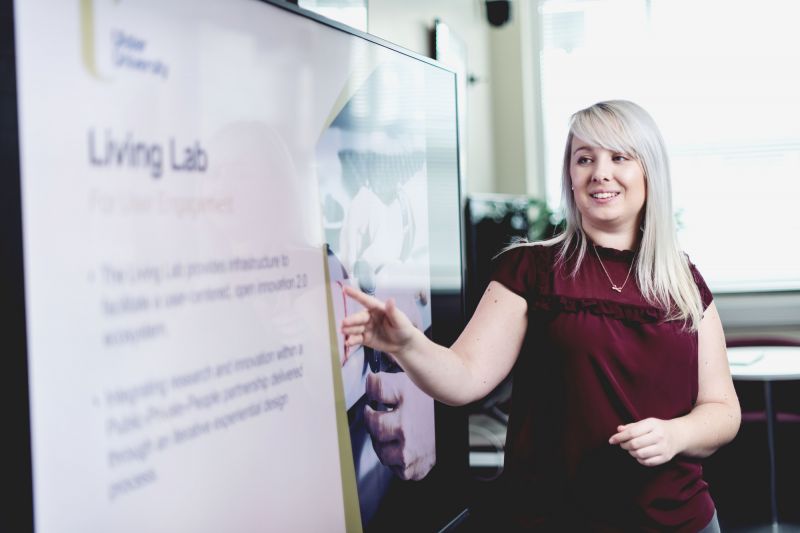What are academic presentations?
Academic presentations are a form of oral assessment. Your lecturer will be looking for you to demonstrate an understanding of the topic and its audience, appropriate and evidenced reading, an argument and reliable, credible and academic sources.
They are a way for you to demonstrate that you meet your learning outcomes, that you understand the topic area, and you can communicate this effectively.
Presentations are developed with an imagined audience in mind, and the presentation content and delivery should reflect your audiences requirements.
The planning of your presentation is fundamental to its success. You must reflect on what your presentation is about, who your audience will be and why you are developing the presentation.
Planning
Planning your presentation is critical. Although it is not a written assessment, there should still be academic rigour evident. You should undertake your research in a thorough way. Marks will be allocated to content, as well as delivery. You might also be expected to take questions about your presentation afterwards, so a clear understanding of your topic area is crucial.
You might also want to think about what resources you will need. Do you require specific hardware, software or other resources?
Structure
Like any other type of assessment, your presentation should flow logically.
The best way to achieve this is to produce a structure containing an introduction, main body and conclusion:
Structuring a presentation
Introduction
- The introduction should include an introduction to the speaker
- Provide a synopsis of the topic being presented
- Give guidance to the audience around when to ask questions etc.
Main Body
- The main body of the presentation is where you present your main argument.
- The slides should be sequenced and logical, and scaffold your ideas
- The content should align to your introduction and conclusion
Conclusion
- Make a positive last impression
- Return to the topic area
- Summarise your evidence/main body
- Deliver a conclusion
- Thank the audience for their attention
- Ask for questions or feedback
Content
Presentations are a visual medium and as such should be engaging and effective. Less is more. Ensure that your slides can be seen and understood by the audience. Keep the design simple to aid inclusivity.
Think about the visual aspects outlined below:
Visual elements of presentations and best practice| Element | Best Practice |
|---|
|
Font
|
Select a good, readable font. Keep your font consistent throughout your presentation. Use font size to create hierarchy. A larger font size will indicate where to look first. Headings should be at least 28 point and main text 20 point.
|
|
Line Spacing
|
Ensure at least 1.5 spacing between lines. Left aligned is easiest to read.
|
|
Case
|
Avoid uppercase as it projects screaming, and is more difficult to read.
|
|
Colour
|
Keep colours simple, and select a colour palette with contrasts. Make sure the colours don't distract from the message.
|
|
Visuals
|
Images add interest and can be impactful. Use graphs, tables, maps etc. to illustrate points. Keep key points clear and concise. Label any images.
|
|
Inclusivity
|
Avoid using different colours- use underlines/bold for emphasis. Keep a high contrast between text and background. Deliver the content orally and avoid asking audience to read directly from the screen. Allow time for the content to be read. Provide handouts.
|
Time
Using your time within a presentation is a core skill, and usually will constitute part of your marking rubric. Practice staying within your time allocation. If it is a group presentation, practice as a collective and make everyone aware of their allocated time. Sometimes it is helpful to allocate a time keeper who will monitor the time and signal to keep everyone right. Generally you should allow around two minutes per slide.
Planning for Questions
Here are some techniques to think about when planning for questions:
- Anticipate possible questions and rehearse them
- Never say 'I don't know'. Suggest that with further time you might investigate the question further.
- If the question refers to your content, go back to the slide to help prompt your memory
- Try to stay clam and focused
- At the end of your presentation you could provide additional slides for further discussion, pre-empting likely questions and demonstrating your thorough understanding
Delivery
Practise makes perfect! The key to success here is to practise. Top tips include:
- Face the audience, not the screen. Do not obscure your slides
- Keep body language confident, open and relaxed
- Leave your arms by your side, and keep your head up
- Introduce yourself initially and professionally
- Speak clearly with an audible tone
- Make eye contact
- Take your time. Pause between slides to gather your thoughts and leave some time to your audience to reflect
Group Presentations
Planning is crucial for group presentations. Determine within the group who will speak and when, responsibility to prepare and format slides and how to manage the research.
Introduce each member of the group at the start of the presentation, and incorporate transitions between slides and presenters.
Planning and Writing Presentations
Self Paced guide
Aims of the guide:
- To define the purpose of your presentation
- Identify the key messages of your presentation
- Create an effective structure for your presentation
- Write the content of your presentation
- Edit your presentation to fit the format requirements
How to access the guide
Use the back and next buttons at the bottom right of the screen below to navigate through the guide. Alternatively, use the contents button to jump to a specific page.
Accessibility options are available at the bottom left-hand corner of the screen.
Delivering your Presentation
Self Paced Guide
Aims of the guide:
- Prepare effectively to deliver your presentation
- Identify potential causes of anxiety
- Build your confidence and deal with nervousness
- Incorporate techniques to help you speak effectively
- Better understand the importance of body language
How to access the guide
Use the back and next buttons at the bottom right of the screen below to navigate through the guide. Alternatively, use the contents button to jump to a specific page.
Accessibility options are available at the bottom left-hand corner of the screen.
Further resources
Here are some free image and photo websites to help you develop visually engaging presentations.
These websites offer thousands of public domain and CC images that are free for re-use and modification.
Check the details of each website carefully as some will need attribution as part of the licence.
Find templates for UU presentations here
Olivia Mitchel speaking about presenting
You can access information and develop your digital skills by accessing our Digital Literacy guide.


















